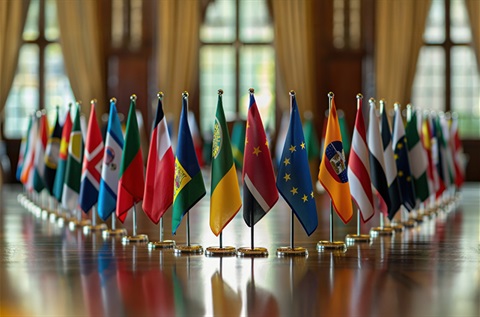Introduction: From Unipolarity to Multipolarity
The Cold War was defined by a bipolar world order, with the United States and the Soviet Union dominating global affairs. The post–Cold War era, particularly the 1990s and early 2000s, was marked by American unipolarity, where U.S. economic, military, and cultural power appeared unrivaled. Yet, as the 21st century unfolds, the world is moving toward multipolarity, where multiple centers of power—political, economic, and technological—reshape the global order.
This essay explores how multipolarity influences international relations, examining the drivers of change, the regional manifestations of power shifts, and the implications for global governance.
1. Understanding Multipolarity in Theory and Practice
1.1 Definition
Multipolarity refers to a distribution of power among three or more states or blocs, none of which can dominate the international system alone.
1.2 Drivers of Multipolarity
- Economic Shifts: The rise of China, India, and other emerging markets.
- Technological Competition: AI, 5G, and renewable energy as arenas of rivalry.
- Declining U.S. Dominance: Military overstretch, domestic polarization, and relative economic decline.
- Regionalism: Stronger regional organizations like the EU, ASEAN, and African Union.
2. Regional Power Centers in the 21st Century
2.1 United States: Enduring Power, Relative Decline
- Maintains global military superiority and soft power influence.
- Faces challenges from internal divisions and strategic overstretch.
- Still central to alliances like NATO, but less able to dictate unilaterally.
2.2 China: The Challenger
- Economic rise makes China the second-largest economy.
- Expands influence through Belt and Road Initiative (BRI).
- Assertive in South China Sea and technology competition.
- Challenges U.S. hegemony while presenting an alternative development model.
2.3 European Union: The Normative Power
- Projects influence through regulations, trade policies, and climate diplomacy.
- Faces internal fragmentation (Brexit, populism) but remains a key global player.
2.4 Russia: The Strategic Disrupter
- Uses military power, energy exports, and hybrid warfare to assert itself.
- Influence remains significant in post-Soviet space, Middle East, and through alignment with China.
2.5 Global South Rising
- India, Brazil, Turkey, South Africa, and ASEAN members play balancing roles.
- Push for reform of global institutions (UN Security Council, IMF, WTO).
- Growing influence in climate negotiations and supply chain diversification.

3. Economic Multipolarity: The Shifting Balance of Wealth
- China and India: Drive global growth, shift investment flows.
- Resource Power: Middle Eastern and African states leverage natural resources to enhance bargaining power.
- Regional Trade Blocs: RCEP, Mercosur, and African Continental Free Trade Area (AfCFTA) reshape trade patterns.
Case Study: The U.S.-China trade war illustrates how multipolar competition destabilizes global supply chains and forces states to diversify alliances.
4. Security Multipolarity: New Alignments and Conflicts
- U.S.-China Rivalry: Central to global security dynamics.
- Russia-NATO Confrontation: Renewed tensions in Europe, especially after the Ukraine conflict.
- Middle East Multipolarity: Saudi Arabia, Iran, Turkey, and Israel compete for influence, while external powers intervene.
- Indo-Pacific Strategy: Quad (U.S., India, Japan, Australia) and AUKUS counterbalance China.
Case Study: The Ukraine War illustrates multipolar conflict management, where Western sanctions, Chinese neutrality, and Global South ambivalence reshape alliances.
5. Governance in a Multipolar World
5.1 Decline of U.S.-Led Institutions
- WTO gridlock, weakened UN authority, and disputes in IMF reform.
5.2 Rise of Alternative Institutions
- BRICS, Asian Infrastructure Investment Bank (AIIB), Shanghai Cooperation Organization (SCO).
- Reflect desire for multipolar governance beyond Western dominance.
5.3 Global Issues Require Collective Action
- Climate change, pandemics, and cyber threats demand cooperation.
- Multipolarity complicates consensus but also broadens stakeholder engagement.
6. Opportunities and Risks of Multipolarity
Opportunities
- Balance of Power: Prevents unilateral dominance.
- Diverse Leadership: More inclusive global governance.
- Innovation through Competition: States push for breakthroughs in technology and development.
Risks
- Instability: Rivalries may trigger regional conflicts.
- Fragmentation: Lack of consensus undermines responses to global crises.
- Economic Decoupling: Multipolar trade blocs may reduce globalization benefits.
7. Case Studies of Multipolar Dynamics
- U.S.-China Rivalry in Africa: Competing investments in infrastructure and technology.
- EU Climate Diplomacy: Norm-setting power influences global supply chains.
- Middle East Realignment: Regional multipolarity reflected in shifting alliances between Gulf states, Iran, and external powers.
Conclusion: The Multipolar Century
The 21st century marks a demographic, economic, and political turning point. Multipolarity does not simply mean a balance of several great powers—it means a redefinition of how power is exercised, shared, and contested.
The challenge ahead is whether multipolarity will lead to cooperative pluralism or competitive fragmentation. Success depends on whether emerging powers and established ones can create institutions that balance competition with collaboration.
In this new global order, multipolarity is both a reality and a test: it demands innovative diplomacy, inclusive governance, and a recognition that no single power can shape the world alone.
















































